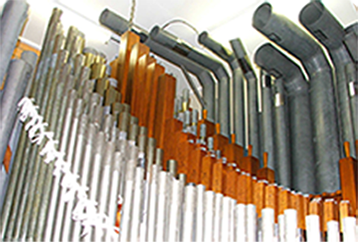If you sit down at a Theatre Pipe Organ console and encounter a stop such as an “8’ Violin Celeste”, it means that a second rank of pipes is installed, identical to the “8’ Violin”, but tuned slightly sharp of true pitch. Celeste ranks are mainly used in conjunction with string stops such as the Salicional, Gamba, Viol D’Orchestre, and Violin, although flute Celestes (tuned slightly flat of true pitch), and Vox Humana Celestes are sometimes found.
When the same note of two organ pipes are not dead in tune with each other, a warm undulation is heard which is very beautiful and useful in imitating bodies of strings in an orchestra. This is nothing like a tremulant or vibrato. It is unique unto itself.
No two violinists in an ensemble play precisely the exact same note. The notes that each produce vary microscopically from each other, creating a noticeably warm effect.
The result of using Celeste stops in the organ is a fullness and richness of tone which imitates an orchestral sound that could not be obtained by any other means. Because Celeste stops make the sound more orchestra authentic, they should ALMOST ALWAYS be utilized whenever their in-tune brothers are included in the registration. One exception – You should NOT use Celeste ranks if you turn off the tremulants to play classical organ music.
Please do not confuse the use of the word “Celeste” referring to organ ranks with the musical instrument of the same name. The term “Celeste” or “Celesta” also means a percussion instrument resembling a small upright piano. Felt hammers strike metal tone bars, creating the sound. Adaptations of this instrument do appear as tuned percussion in some Theatre Pipe Organs.










